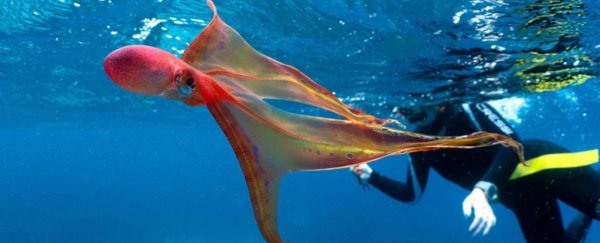A mesmerizing new video shows a "once-in-a-lifetime encounter" with a bizarre, bright red octopus swimming above the Great Barrier Reef in northeastern Australia.
The encounter, first reported by local Australian news website Bundaberg Now, was a rare sighting of a blanket octopus, named after the blanket-like fleshy cape between its arms. Jacinta Shackleton, a marine biologist and reef guide, filmed and photographed the octopus while diving off the coast of Lady Elliot Island in Queensland on January 6.
"When I first saw it I thought it could have been a juvenile fish with long fins, but as it came closer I realized it was a blanket octopus and I was overjoyed and couldn't contain my excitement!" Shackleton told Bundaberg Now.
Related: 8 crazy facts about octopuses
Blanket octopuses are a small group of rarely-seen octopuses in the genus Tremoctopus, according to the Great Barrier Reef Foundation, a non-profit working to protect the iconic reef. Shackleton encountered the young female in shallow waters, which is especially rare as these octopuses normally live in the open ocean.
"The colors in her cape were incredible and it was fascinating to watch the way she moved through the water," Shackleton wrote on her Instagram account, @jacintashackleton, where she posted the video and photos of the encounter.
View this post on Instagram
Only female blanket octopuses have capes, which they can remove in a pinch to distract or hit predators with – just like Doctor Strange's magical cloak from Marvel.
Females are also much, much bigger than males and grow up to about 6.6 feet (2 meters) long, while males are less than 1 inch (2.4 centimeters) long, according to the Great Barrier Reef Foundation. This is one of the largest size differences between the sexes of any animal.
For males to reproduce with much larger females, they detach their hectocotylus, a modified arm male octopuses use to deliver sperm, and insert it into a female, Live Science previously reported. Blanket octopuses are also known for their strange hunting strategy of ripping off the tentacle of a toxic jellyfish and using it as a weapon to catch prey.
Shackleton described the experience as a once-in-a-lifetime encounter.
"A lot of images have come from individuals in captivity so I believe I'm extremely lucky to have seen one during the day, on the reef and in the wild and to have had two cameras with me!" she told Bundaberg Now.
Related Content:
Octlantis: See photos of tight-knit gloomy octopus communities
Elusive glass octopus spotted in the remote Pacific Ocean (Video)
Deep blue sea: Winning underwater photographs
This article was originally published by Live Science. Read the original article here.
